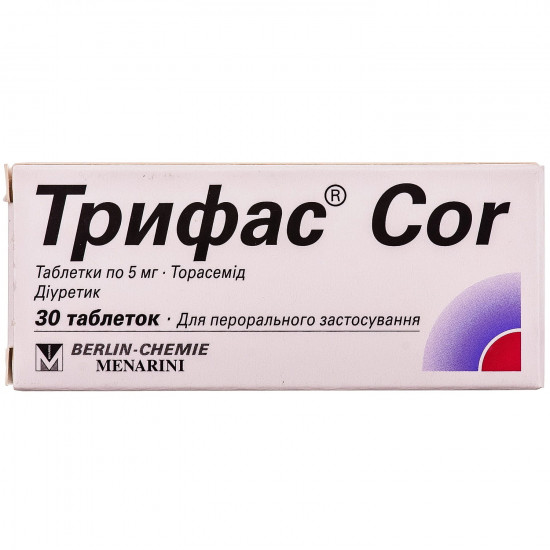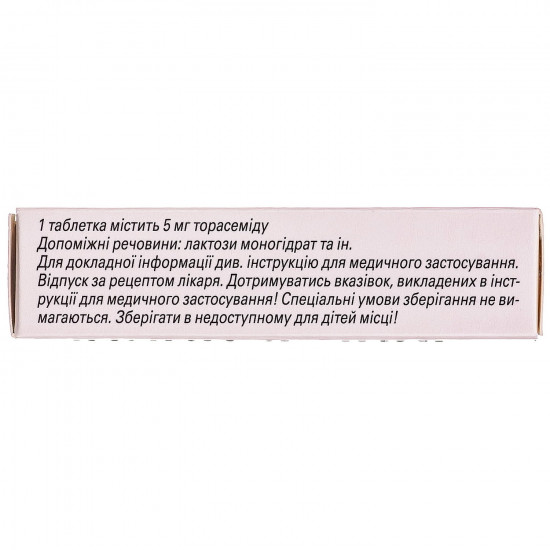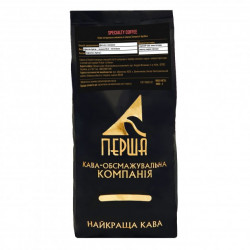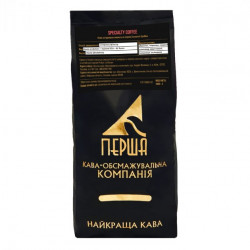



- Stock: In Stock
- Model: 182784
0% Customers recommend this product
-
5 Awesome0%
-
4 Great0%
-
3 Average0%
-
2 Bad0%
-
1 Poor0%
Reviews Over Trifas COR of the tab. of 5 mg No. 30
- (0)
Total Reviews (0)
click here write review to add review for this product.
Report this review.
Description
Pharmacological properties
Pharmacodynamics. torasemid works as saluretic, its action is connected with oppression of renal absorption of ions of sodium and chlorine in the ascending part of a Henle's loop. at the person the diuretic effect quickly reaches the maximum during the first 2–3 h later in/in and oral administration respectively and remains to constants for nearly 12 h at healthy volunteers in the range of doses of 5-100 mg the increase in a diuresis proportional to a dose logarithm (loopback activity of diuretic) is noted. increase in a diuresis is registered even when other diuretics, for example distally the operating effective diuretics of a tiazidovy row, did not render the necessary effect, for example in a renal failure any more. thanks to such mechanism of action torasemid leads to reduction of hypostases. in case of heart failure torasemid reduces manifestations of a disease and improves functioning of a myocardium due to reduction pre- and afterloads. after intake the antihypertensive action of a torasemid develops gradually, since 1st week after an initiation of treatment. the maximum of antihypertensive action is reached not later than in 12 weeks torasemid lowers arterial blood pressure due to decrease opss. this influence is explained by normalization of the broken electrolytic balance mainly due to decrease in superactivity of free calcium ions in cells of muscles of arterial vessels that is revealed at patients with ag. possibly, this influence reduces the increased susceptibility of vessels to endogenous angiotonic substances, for example catecholamines.
Pharmacokinetics. After oral administration torasemid it is quickly and completely soaked up. The C max in blood plasma is reached during 1–2 h. The bioavailability is 80–90%; on condition of full absorption the maximum value of effect of the first passing is 10–20%. Food reduces the speed (dynamic component) of absorption of a torasemid (the C max decreases and time of achievement of the C max — t max ) increases, but does not influence the general absorption. Linking of a torasemid with proteins of blood plasma makes more than 99%, metabolites of M1, M3, and M5 — 86; 95 and 97% respectively. The volume of distribution (Vz) is 16 l. At the person torasemid the M3 and M5 is metabolized with formation of three metabolites of M1. Proofs of existence of other metabolites are absent. Metabolites of M1, M3 and M5 are formed as a result of oxidation of methyl group which is on a phenylic ring, to carboxylic acid, the metabolite of M3 is formed as a result of hydroxylation of a ring. The metabolites of M2 and M4 viyavlenny in researches on animals, at the person are noted. The pharmacokinetics of a torasemid and its metabolites is characterized by linear dependence. It means that its C max in blood plasma and AUC increase in proportion to a dosage. Final T ½ a torasemid and its metabolites at healthy people makes 3–4 h. The general clearance of a torasemid reaches 40 ml/min., renal clearance — about 10 ml/min. At healthy people about 80% of the entered dose it is removed in the form of a torasemid and its metabolites in the following percentage: torasemid — about 24%, M1 metabolite — about 12%, M3 metabolite — about 3%, M5 metabolite — about 41%. The main metabolite of M5 of diuretic effect has no, and about 10% of all pharmakodinamichesky action together are the share of a share of metabolites of M1 and M3. In a renal failure the general clearance and T ½ a torasemida do not change, and T ½ with M3 and M5 is extended. However pharmakodinamichesky characteristics remain invariable, and the severity of a renal failure does not influence duration of action. At patients with an abnormal liver function or with heart failure of T ½ a torasemid and a metabolite of M5 are slightly extended, and the amount of substance which is removed with urine is almost completely equal to quantity removed at healthy people therefore accumulation of a torasemid and its metabolites does not happen. Torasemid and his metabolites are practically not removed at a hemodialysis and haemo filtration.
Indication
Essentsialnaya ag. treatment and prevention of a recurrence of hypostases and/or exudates owing to heart failure.
Trifas of the 20th ampoule. Treatment of the hypostases and/or exudates caused by heart failure if it is necessary in/in medicine use, for example in case of a fluid lungs owing to an acute heart failure.
Trifas 200 is shown toexclusively sick with considerable deterioration in function of kidneys (clearance of creatinine of 20 ml/min. and/or concentration of creatinine in blood plasma of 6 ml/dl). For preservation of a residual diuresis in a heavy renal failure and also in the conditions of a hemodialysis in the presence though any residual diuresis (200 ml during 24 h) if there are hypostases, an exudate and/or increase in the ABP.
Use
Essential hypertensia. to begin treatment with use ½ tablets trifas with cor in day that is equivalent to 2.5 mg of a torasemid. decrease hell happens gradually, within 1 week of treatment, and reaches the maximum value no later than 12 weeks if normalization hell at daily use ½ tablets does not happen in 12 weeks of treatment, then the daily dose can be raised to 1 tablet trifas by cor that is equivalent to 5 mg of a torasemid. at initial high rates hell and also at bounded function of kidneys it is possible to count on additional decrease hell due to increase in a dose. it is not necessary to exceed a daily dose of medicament trifas cor which makes 1 tablet as at the same time further decrease hell is not expected.
Hypostases and/or exudates. Treatment is begun with use of 1 tablet in day of the medicament Trifas Cor or ½ tablets Trifas 10 that makes 5 mg of a torasemid. Usually this dose is considered supporting. If the daily dose of 5 mg is not enough, then it is necessary to apply 10 mg of a torasemid which is appointed daily. Depending on weight of a condition of the patient the daily dose can be raised to 20 mg of a torasemid.
to applyTablet in the morning, without chewing, washing down with a small amount of liquid. Duration of treatment is determined, proceeding from the course of the disease. The bioavailability of a torasemid does not depend on meal.
Recommendation about division of a tablet. Tablets can be easily divided into two half (risk for division is on one party) that provides a possibility of receiving a necessary dose. To place a tablet on a firm surface. Then to press thumbs on the right and to the left of risks for division. It provides easy division of a tablet.
Dosage of tablets Trifas 200 is established individually depending on severity of a renal failure. Treatment it is necessary to begin with use ¼ tablets Trifas 200 in day that is equivalent to 50 mg of a torasemid. In case of insufficient urination the dose can be raised up to ½ tablets Trifas 200 that corresponds to 100 mg of a torasemid. The maximum daily dose makes 1 tablet of medicament Trifas 200 that is equivalent to 200 mg of a torasemid. Tablets easily are divided into 2 or 4 parts at the expense of applied on them risok. A pill is taken in the morning, without chewing, and wash down with a small amount of liquid.
Trifas of the 20th ampoule
Adult. To begin treatment with reception of a single dose 2 ml Trifas the 20th ampoules that is equivalent to 10 mg of a torasemid a day. If the effect is insufficient, then the single dose can be raised to 4 ml of medicament Trifas of the 20th ampoule that is equivalent to 20 mg of a torasemid. If effect and in this case is insufficiently, it is possible to perform short-term (during no more than 3 days) therapy with introduction of a daily dose of 8 ml of the medicament Trifas of the 20th ampoule that is equivalent to 40 mg of a torasemid.
Acute fluid lungs. Treatment it is necessary to begin 4 ml of the medicament Trifas of the 20th ampoule with introduction of a single dose that is equivalent to 20 mg of a torasemid. Depending on effect, the dose can be repeated at an interval of 30 min. It is forbidden to exceed the maximum daily dose of 20 ml of the medicament Trifas of the 20th ampoule that is equivalent to 100 mg of a torasemid.
Solution for injections to enterin/in slowly. Solution in / is forbidden to enter and! To enter only pure solution. At prolonged use the introduction needs to be replaced with oral administration as the Note is not recommended to spend 7 days in to use of medicament
as soon as possible. The address with the ampoules opening in one point. It is not required to Nadpilivat ampoules.
Patients with an abnormal liver function. Treatment of such patients should be carried out with care as increase in concentration of a torasemid in blood plasma is possible.
Patients of advanced age. Special selection of a dose is not required. Unfortunately, adequate researches concerning comparison of treatment of patients of advanced and young age are absent.
Contraindication
Hypersensitivity to a torasemid, compounds of sulphonylurea and other components of drug; arterial hypotension; a renal failure with an anury; hepatic coma or prekoma; hypovolemia, hyponatremia, hypopotassemia; arrhythmia; the significant disturbances of urination (for example owing to a prostatauxe); feeding period breast.
200 cannot appoint the Drug Trifas in addition in a normal or moderate renal failure (clearance of creatinine of 30 ml/min. and/or concentration of creatinine in blood plasma of 3.5 mg/dl) in connection with danger of excessive loss of water and electrolytes.
bySide effects
For assessment of side effects used the following frequency of their manifestations: very often (≥1/10); often (from ≥1/100 to 1/10); sometimes (from ≥1/1000 to 1/100); seldom (from ≥1/10 000 to 1/1000); very seldom (1/10,000); it is unknown (it is impossible to estimate on the available data).
Metabolisms/electrolytes: often — an intensification of a metabolic alkalosis, spasms of muscles (especially in an initiation of treatment), increase in concentration of uric acid and glucose in blood plasma and also XC and TG, a hypopotassemia at the accompanying low-calorie diet, vomiting, diarrhea, after excessive use of depletive and also in chronic dysfunction of a liver. Depending on dosing and duration of treatment disturbances of water and electrolytic balance, for example a hypovolemia, a hypopotassemia and/or a hyponatremia are possible.
Cardiovascular system: very seldom — in view of a possible pachemia there can be tromboembolic episodes, confusion of consciousness, arterial hypotension and also disturbances of blood circulation and warm activity, including ischemic disturbances from heart and a brain that can lead to arrhythmia, stenocardia, an acute myocardial infarction, a syncope.
Digestive systems: often — various disturbances from a digestive tract (especially in an initiation of treatment), for example lack of appetite, a gastralgia, nausea, vomiting, diarrhea, a constipation, a meteorism; very seldom — pancreatitis.
Kidney and urinary tract: sometimes — increase in concentration of creatinine and urea in blood plasma. At urination disturbance (for example in a prostatauxe) the increased formation of urine can lead to its delay and a recystectasia. Desires to urination.
from a gepatobiliarny system: often — increase in concentration of some liver enzymes (gamma glutamiltranspeptidazy) in blood plasma.
from the immune system: very seldom — allergic reactions, for example an itching, a dieback, a photosensitization, heavy skin reactions, rash.
System of blood: very seldom — reduction of quantity of thrombocytes, erythrocytes and/or leukocytes.
General manifestations: often — a headache, dizziness, increased fatigue, the general weakness (especially in an initiation of treatment); sometimes — dryness in a mouth, unpleasant feelings in extremities (paresthesia); very seldom — disorders of vision, a ring in ears, a hearing loss. At considerable losses of liquid and electrolytes owing to the strengthened urination there can be arterial hypotension, a headache, an asthenia, drowsiness, especially in an initiation of treatment and at patients of advanced age; it is unknown — local reactions after injections.
Special instructions
needs to eliminate withbefore use of medicament the existing hypopotassemia, a hyponatremia or a hypovolemia.
regular control of electrolytic balance (especially at patients who at the same time apply glycosides of a foxglove, GKS, a mineralokortikosteroida or depletive), including potassium in blood plasma is necessary forAt prolonged use of a torasemid.
Torasemid should be applied with extra care at patients with the liver diseases which are followed by cirrhosis and ascites as sudden changes of water and electrolytic balance can lead to a hepatic coma. Patients of this group need to carry out therapy using a torasemid (as well as other diuretics) in the conditions of a hospital. For prevention of a hypopotassemia and a metabolic acidosis it is necessary to appoint medicament with medicaments — antagonists of Aldosteronum or the medicaments promoting a potassium delay in an organism. After use of drug, ototoxicity cases (sonitus and a hearing loss) which had reversible character are noted, however direct link with use of medicament is not established.
When prescribing diuretics needs to control carefully clinical symptoms of disturbance of electrolytic balance, a hypovolemia, an extrarenal azotemia and other disturbances which can be shown in the form of dryness in a mouth, thirst, weakness, slackness, drowsiness, excitement, muscular pain or spasms, a myasthenia, hypotonia, an oliguria, tachycardia, nausea, vomiting. The excessive diuresis can become the cause of dehydration of an organism, lead to reduction to OCK, a thrombogenesis and an embolism, especially at patients of advanced age.
to Patients with disturbances of water and electrolytic balance needs to stop use of medicament and after elimination of undesirable effects to resume therapy, since lower doses.
besides, regular control of level of glucose, uric acid, creatinine and lipids in blood is necessary for. Because at treatment by diuretic glucose content in blood can increase, careful check of metabolism of carbohydrates is necessary for patients with the latent and available diabetes. Regular control of a picture of blood (erythrocytes, leukocytes, thrombocytes) is also necessary. In an initiation of treatment of patients of advanced age it is necessary to pay special attention to emergence of symptoms of loss of electrolytes and a pachemia.
should not appointIn view of lack of sufficient clinical experience of use torasemid in the following diseases and states. Gout. Arrhythmia, for example sinuatrial blockade, AV blockade ІІ and ІІІ degrees. Pathological changes of acid-base metabolism. The accompanying therapy using medicaments of lithium, aminoglycosides or cephalosporins. Pathological changes of a gemogramma, for example thrombocytopenia or anemia at patients without renal failure. The renal failure caused by nephrotoxic substances. Drug contains lactose therefore it patients should not appoint with hereditary deficiency of lactase, intolerance of a galactose or narusheny metabolism of a glucose/galactose. Trifas 200 do not apply at clearance of creatinine 20–30 ml/min. and/or concentration of creatinine in blood plasma of 3.5-6 mg/dl.
Use of the medicament Trifas can become the reason of positive take at test for doping and aggravations of symptoms of health.
Period of pregnancy and feeding by a breast. Pregnancy. Reliable data about influence of a torasemid on an embryo and a fruit of the person are absent.
toIn experiments on animals showed reproductive toxicity of a torasemid. Torasemid gets through a placental barrier. Due to the aforesaid torasemid apply during pregnancy only at emergency and in minimum possible effective dose. Diuretics are unsuitable for the standard scheme of treatment at AG or hypostases at pregnant women as they are capable to reduce perfusion of a placental barrier and by that to slow down pre-natal fetation. If torasemid apply to treatment of pregnant women with heart failure or a renal failure, then it is necessary to carry out careful monitoring of electrolytes and a hematocrit and also fetation.
feeding Period breast. Now it is not established whether gets torasemid into breast milk at animals or the person. It is impossible to exclude risk of use of medicament for newborns/children of chest age. Therefore use of medicament during feeding by a breast contraindicated. If it is necessary to apply torasemid during this period, then breastfeeding is stopped.
Fertility. Researches of influence of a torasemid on fertility at people were not conducted. In an experiment on animals such influence of a torasemid is not revealed.
Children. Drug is not used at children due to the lack of sufficient clinical experience.
Ability to influence speed of response at control of vehicles and work with other mechanisms. Even at appropriate use torasemid can influence reaction of the patient to such an extent that it will entail considerable negative impact on ability to run vehicles or other mechanisms or to perform work without secure. It mainly concerns such cases as an initiation of treatment, increase in a dose of drug, replacement of medicine or when assigning of the accompanying therapy. Therefore during use of medicament it is necessary to be very careful at control of vehicles or other mechanisms.
Interaction
Torasemid strengthens effect of other antihypertensive drugs, in particular inhibitors apf. at their simultaneous use perhaps excessive decrease hell. at the combined use of a torasemid with digitalis medicaments the deficiency of potassium caused by diuretic can lead to strengthening of side effect of both drugs. torasemid can reduce efficiency of antidiabetic means. probenetsid and npvp (for example indometacin, acetylsalicylic acid) can reduce diuretic and hypotensive action of a torasemid. at treatment by salicylates in high doses torasemid can strengthen their toxic action on central nervous system. torasemid, especially in high doses, can strengthen from - and nephrotoxic action of aminoglikozidny antibiotics (for example Kanamycinum, gentamycin, Tobramycinum) and tsitostatik — platinum derivatives and also nephrotoxic effect of cephalosporins. torasemid can strengthen effect of theophylline and kurarepodobny muscle relaxants. depletive and also mineralokortikoida and gks can increase the possible losses of potassium caused torasemidy. at simultaneous use of a torasemid and medicaments of lithium the concentration of lithium in blood with strengthening of its action and side effects can increase. torasemid can weaken vasoconstrictive effects of catecholamines, for example epinephrine and Norepinephrinum. at the combined use with Colestyraminum the absorption of a torasemid and, respectively, its efficiency can decrease.
Overdose toTypical symptomatology is unknown to
. at overdose there can be a significant increase in a diuresis, including the risk of the significant loss of water and electrolytes, drowsiness, an amental syndrome (one of consciousness disturbance forms), symptomatic arterial hypotension, cardiovascular insufficiency and disturbances from a GIT increases.
Treatment: there is no specific antidote. Symptoms of intoxication disappear, as a rule, at a dose decline and cancellation of medicine and at the corresponding substitution of liquid and electrolytes (it is necessary to carry out control!). Torasemid is not brought from blood by means of a hemodialysis. Treatment at a hypovolemia: completion of volume of liquid. Therapy at a hypopotassemia: prescribing of medicaments of potassium. Treatment of cardiovascular insufficiency: position of the patient lying with the raised legs and if necessary — purpose of symptomatic therapy.
Acute anaphylaxis (urgent measures): at the first emergence of skin reactions (such as urticaria or dermahemia), the excited condition of the patient, a headache, a hyperhidrosis, nausea, cyanosis carry out vein catheterization; the patient is brought into horizontal position, provide free intake of air, appoint oxygen. If necessary enter epinephrine, the substituting solutions, GKS.
Storage conditions
does not demand special storage conditions.
Trifas 200, Trifas of the 20th ampoule. To store at a temperature not above 25 °C.
Specifications
| Characteristics | |
| Active ingredients | Torasemid |
| Amount of active ingredient | 5 mg |
| Applicant | Berlin-Chemie Menarini |
| Code of automatic telephone exchange | C03CA04 Torasemid |
| Interaction with food | It doesn't matter |
| Light sensitivity | Not sensitive |
| Market status | The branded generic |
| Origin | Chemical |
| Prescription status | According to the prescription |
| Primary packing | blister |
| Producer | BERLIN-HEMI AG |
| Quantity in packing | 30 tablets (3 blisters on 10 pieces) |
| Release form | tablets for internal use |
| Route of administration | Oral |
| Sign | Import |
| Storage temperature | from 5 °C to 25 °C |
| Trade name | Trifas |




















